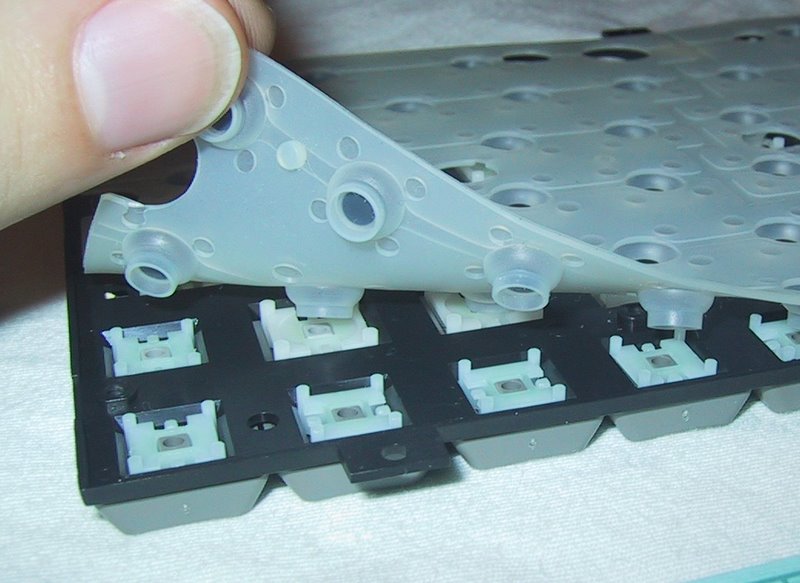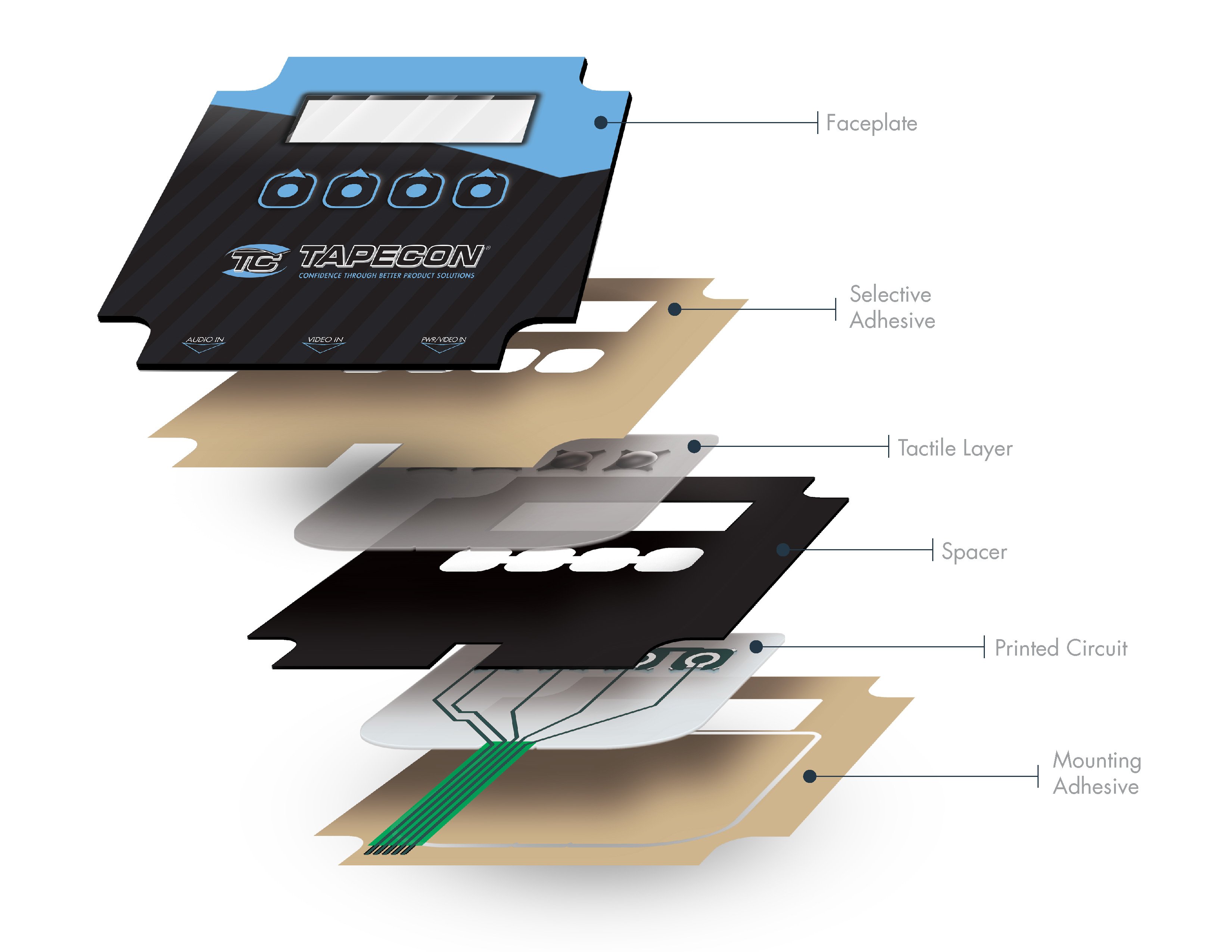Established Membrane Switch Manufacturer for Premium Control Panels
Established Membrane Switch Manufacturer for Premium Control Panels
Blog Article
Discovering the Manufacturing Process of Membrane Switch for Various Industries
The manufacturing procedure of Membrane buttons is a complex venture that requires precision and focus to information. From choosing suitable products to implementing rigorous top quality control measures, each action plays a vital function in making sure capability. Different industries, including vehicle and clinical, rely upon these elements for their special applications. Recognizing the complexities of this process discloses considerable understandings right into how these switches are generated and their impact across varied fields.
Comprehending Membrane Switches Over: An Overview

Trick Products Made Use Of in Membrane Switch Manufacturing
In Membrane button manufacturing, the option of vital products considerably influences performance and resilience. Conductive materials, adhesives, and layers play essential roles, while substratum selection influences general performance and dependability. Understanding these parts is vital for enhancing the style and manufacturing of Membrane buttons.
Conductive Materials Introduction
Conductive materials play an important role in the functionality of Membrane buttons, guaranteeing trustworthy electrical connections within the device. Frequently utilized materials include silver, copper, and carbon-based inks, each offering distinct benefits. Silver is preferred for its high conductivity and durability, making it perfect for applications needing durable performance. Copper, while slightly less conductive than silver, is a cost-effective choice commonly made use of in published circuits. Carbon-based inks supply a flexible option, suitable for applications where flexibility and lower expenses are focused on, although they have lower conductivity contrasted to metal alternatives. The selection of conductive materials directly affects the overall reliability, life-span, and performance of the Membrane switch, making it an essential consideration in the production procedure.
Adhesives and Coatings
Coatings and adhesives are vital elements in the manufacturing of Membrane buttons, supplying important bonding and safety homes. These products guarantee that various layers of the switch, consisting of graphic overlays and wiring, stick firmly to one another, improving longevity and capability. Generally made use of adhesives include pressure-sensitive adhesives (PSAs) and epoxy-based solutions, which use solid bond and strength. Coatings, such as polyurethane or acrylic, serve to shield versus ecological elements, consisting of moisture, abrasion, and chemicals. Furthermore, finishes can enhance responsive comments and visual charm, contributing to the general individual experience. The selection of proper adhesives and finishes is vital for maximizing performance and durability in varied applications across numerous markets, guaranteeing that Membrane switches fulfill specific operational demands.
Substratum Choice Factors
Substratum option plays an important function in the manufacturing of Membrane switches, as it significantly affects their general performance and resilience. Key materials such as polyester, polycarbonate, and flexible printed circuit card (FPCBs) are typically utilized for their unique residential properties. Polyester is favored for its cost-effectiveness and resistance to abrasion, making it appropriate for applications with high wear. Polycarbonate offers superior clearness and effect resistance, ideal for settings requiring high visibility. FPCBs give boosted adaptability and are often used in complicated layouts. The option of substratum additionally influences factors like thermal security, chemical resistance, and simplicity of printing. Ultimately, choosing the appropriate substratum is important for guaranteeing the functionality and durability of Membrane switches across various sectors.
The Style Refine of Membrane Switches
The layout process of Membrane buttons is an important stage that substantially influences the functionality and aesthetic appeals of the final item - membrane switch manufacturer. It starts with specifying the details requirements of the application, including measurements, button layout, and tactile comments preferences. Designers must consider individual interaction, ensuring that the switch is user-friendly and accessible.Next, products are selected based upon sturdiness, adaptability, and environmental resistance. The assimilation of graphics and branding aspects is additionally crucial, as it enhances visual appeal and communication. Prototyping permits iterative screening, enabling modifications based upon individual responses and efficiency evaluations.Additionally, the style has to account for the electric parts, such as circuits and adapters, guaranteeing dependability and ease of usage. Eventually, a successful style integrates capability, visual appeals, and individual experience, leading the way for effective manufacturing and durable efficiency in different markets
Printing Techniques for Membrane Changes
The printing strategies made use of in Membrane button manufacturing play a necessary duty in figuring out the end product's quality and functionality. Display printing supplies advantages such as durability and dynamic color application, while electronic printing innovations supply versatility and precision in design. Recognizing these approaches can greatly influence the overall performance of Membrane switches in numerous applications.
Display Printing Benefits
Many benefits make screen printing a preferred strategy for generating Membrane switches. This approach enables for premium, in-depth layouts and vivid shades, which are vital for interface applications. Display printing is specifically efficient for using thick ink layers, enhancing resilience and tactile responses. In enhancement, it offers outstanding attachment to various substratums, guaranteeing longevity sought after atmospheres. The process is cost-effective for big production runs, as it minimizes setup time and waste. In addition, display printing supports a vast array of inks, consisting of specialty and UV-curable alternatives, allowing convenience in design. Its ability to create consistent results throughout multiple units makes it a trusted choice for producers intending for high quality and effectiveness in Membrane switch production.
Digital Printing Innovations

Innovations in electronic printing technology are transforming the manufacturing of Membrane switches, supplying producers cutting-edge remedies that improve layout flexibility and efficiency. Digital printing permits intricate designs and high-resolution graphics, allowing custom-made branding and functionality without the restrictions of typical methods. This method minimizes configuration times and prices, helping with shorter manufacturing runs and marginal waste, making it perfect for businesses with differing demands. Furthermore, advancements in ink solutions supply far better durability and attachment, ensuring durability in numerous settings. As sectors progressively look for complex and personalized designs, electronic printing sticks out as a crucial technique, establishing a brand-new requirement in Membrane switch manufacturing. The assimilation of these developments positions producers to meet developing market requires effectively.
Setting up and Layering of Membrane Switch Components
Cautious setting up and layering of Membrane button components are essential to assuring capability and durability. This process starts with the specific positioning of various layers, including the visuals overlay, sticky, circuit layer, and support product. Each element should be thoroughly placed to preserve electrical integrity and interface responsiveness.During setting up, conductive traces are related to the circuit layer, normally made from products like polyester or polycarbonate. This layer is crucial, as it transmits signals when pressure is used. The sticky used for bonding these layers is likewise chosen for its capacity to endure environmental stress and anxieties while preserving a protected bond.Heat and stress are frequently used throughout the setting up process to ascertain that the layers stick appropriately without compromising the performance of the button. Ultimately, focus is look at more info offered to the side securing to safeguard against moisture and impurities, protecting the longevity of the Membrane switch in numerous commercial applications.
Top Quality Control Actions in Membrane Switch Manufacturing
Quality control actions play a vital duty in making sure the integrity and efficiency of Membrane switches over adhering to the assembly and layering of their elements. In the manufacturing procedure, numerous essential assessments are performed to promote high quality criteria. These consist of aesthetic examinations for problems in printing and sticky application, in addition to functional tests to validate the responsiveness of each switch.Additionally, ecological screening is carried out to assess the buttons' longevity against temperature level changes and humidity direct exposure. Manufacturers frequently implement analytical procedure control (copyright) techniques to keep an eye on production consistency, allowing very early detection of anomalies.Furthermore, traceability systems are established to track elements and materials, guaranteeing responsibility and assisting in recalls if required. Calibration of tools and adherence to sector standards are additionally important to preserving item integrity. Jointly, these high quality control actions secure the performance of Membrane switches throughout various applications, ultimately boosting client fulfillment.
Applications of Membrane Switches Across Different Industries
Membrane buttons are utilized throughout a diverse array of sectors, showcasing their adaptability and adaptability. In the clinical field, they give reliable and water-proof user interfaces for gadgets such as analysis equipment and infusion pumps, making certain hygiene and convenience of usage. The auto industry uses Membrane buttons for control panel controls, enabling smooth communication in between the motorist and vehicle systems.In customer electronics, these switches are located in devices and portable devices, supplying a streamlined, contemporary aesthetic while boosting capability. Industrial applications additionally utilize Membrane switches over for equipment control panels, where sturdiness and resistance to rough problems are essential.Furthermore, the aerospace and protection markets use Membrane switches for cabin instrumentation and communication systems, prioritizing reliability and efficiency under severe conditions. In general, Membrane buttons play an essential duty in enhancing the customer experience and functional effectiveness throughout different domain names.
Frequently Asked Concerns
For how long Does It Require To Make a Membrane Layer Switch?
The production time for a membrane layer switch normally varies from a few days to numerous weeks - membrane switch manufacturer. Elements influencing this duration include design intricacy, material accessibility, and production volume, all affecting the overall timeline substantially
What Is the Normal Life-span of a Membrane Layer Switch?
The common lifespan of a membrane switch usually varies from 1 to 5 membrane switch manufacturer million actuations, depending on variables such as worldly high quality, ecological problems, and usage frequency, considerably impacting toughness and general performance.
Can Membrane Changes Be Personalized for Specific Applications?
Membrane switches can without a doubt be customized for certain applications. Their layout flexibility permits modifications in size, form, colors, and graphics, making certain compatibility with distinct demands across numerous industries and improving capability and user experience.

Are Membrane Changes Ecologically Pleasant?
The environmental influence of Membrane switches over varies. Some products made use of may not be environment-friendly, official statement while improvements in making processes are increasingly focusing on sustainability, aiming to lower waste and advertise recyclable elements in their production.
What Are the Typical Failure Settings of Membrane Switches?
Usual failing modes of Membrane buttons consist of delamination, adhesive failing, deterioration from use, wetness access, and electrical failures. These problems can substantially influence performance, efficiency, and life expectancy in various applications across various markets. Membrane buttons can be tailored to fit certain style needs, such as dimension, shape, and capability, making them highly adaptable.The building and construction generally involves multiple layers, including a graphic overlay, glue, and a circuit layer, which work together to create a smooth customer experience. In Membrane button manufacturing, the option of crucial materials significantly influences performance and resilience. The auto industry uses Membrane switches for dashboard controls, allowing smooth interaction in between the motorist and lorry systems.In consumer electronic devices, these switches are discovered in appliances and portable gadgets, using a sleek, modern-day visual while boosting functionality. Industrial applications additionally utilize Membrane changes for machinery control panels, where resilience and resistance to extreme problems are essential.Furthermore, the aerospace and defense sectors use Membrane buttons for cockpit instrumentation and communication systems, focusing on reliability and performance under extreme conditions. Membrane switches can certainly be customized for details applications.
Report this page